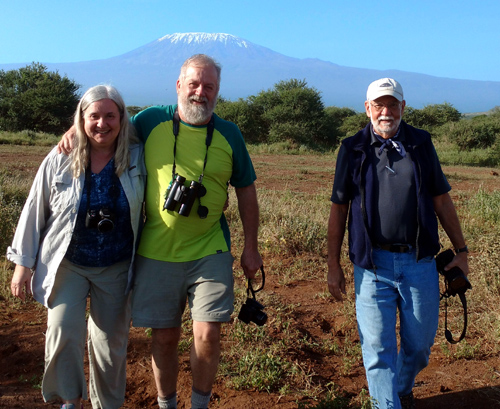
Our six days on Kenya’s Southern Circuit were fabulous, and especially for birders, and believe it or not the entire group are avid birders!
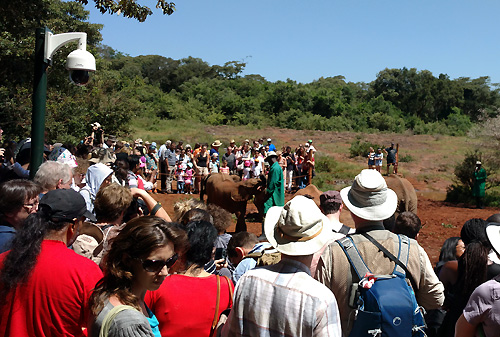 We were among about 400 people at the Sheldrick elephant orphanage yesterday, and I carefully scanned the group noting only five non-white visitors.
We were among about 400 people at the Sheldrick elephant orphanage yesterday, and I carefully scanned the group noting only five non-white visitors.
The day before we visited the Giraffe Centre and I’d roughly estimate that 50% of the visitors there were non-white.
I presume that most of the non-white were Kenyans or Africans. It demonstrates in clear contrast how the local population views elephant conservation versus some other animal conservation, and the reason is the escalating conflict between elephants and people in developing Africa.
The Sheldrick orphanage and the Giraffe Centre are both top Nairobi attractions. It was Sunday, the only day of the week that there is fast-moving traffic on the city’s many highways and thoroughfares, and it was beautiful dry weather.
Tourists came in droves. Kenyans didn’t come.
I believe that under this quiet de facto protest is a growing and serious animus Kenyans feel against conservation driven by outsiders. Kenyans probably are more conservation oriented than many would presume. Several local organizations have saved Nairobi’s forests and its national park. The legendary Wangari Maathai is among the few conservationists to receive a Nobel Prize.
So the animus towards elephant conservation does not imply a general anti-conservation attitude by any means. But elephants have drawn by far and away the most international attention, and it has been exclusively concern expressed for the elephants … rather than for the “ecosystem” or the “national parks” or anything that might include the people, too.
It’s a terrible failing of western animal conservation organizations to have directed their appeals so exclusively outside the areas for which the appeals have been made. True, the possibility of getting donations from mostly emerging and poor countries is very limited, but it would have conveyed a sense of inclusion. Instead, policies have contributed to exclusion for years.
The most common presumption about the value of big game here in Kenya is that it is a commodity that attracts rich foreigners. Particularly as now when the European and Asian economies are declining, and therefore the bulk of tourists decline, there are fewer positive returns from the endeavor.
What is always behind the scenes moves onto center stage: elephants are big, destructive and enormously expensive to conserve. Only the decadent wealthy foreigner insensitive to the desperate need for all sorts of human conservation has a desire to protect them.
The more fulsome arguments regarding ecosystems and biodiversity have no chance, because no serious groundwork has been laid for these more complicated justifications.
So many of Africa’s problems can be laid squarely on the failure of the developed world to treat Africa as an equal part of the human community, and the current acceleration of elephant poaching is no different.
Until western conservationists recognize the sovereignty of Africa in all things African, including its elephants, there will be no change.
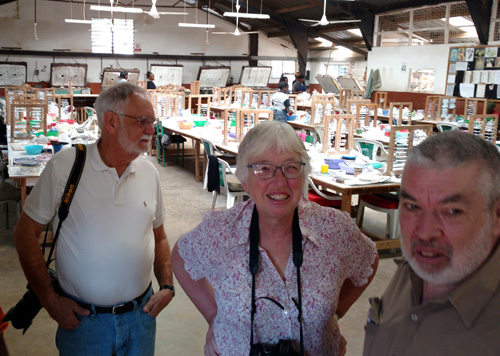
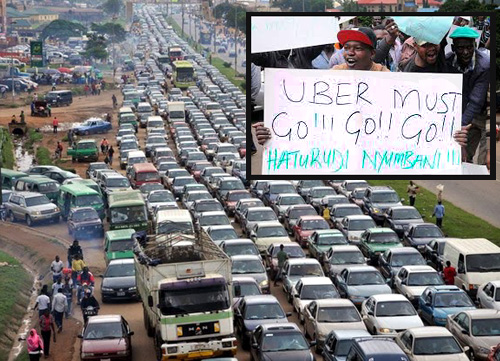 In Nairobi and New York consumers were mad, local government knew what it had to do but claimed not to have the money to do it, so private investors stepped in: Uber Alles.
In Nairobi and New York consumers were mad, local government knew what it had to do but claimed not to have the money to do it, so private investors stepped in: Uber Alles.
Today the head of the Nairobi taxi association gave the government one week to “do away with” Uber or they will “grind the city to halt.”
That won’t be hard to do, since the city is more or less ground to a halt already. The 10-12 mile ride from the airport into the city normally takes two hours because of unbelievable traffic.
The government seems to be siding with Uber.
Tension is seriously building. Uber has been here for just over a year, and rates Nairobi as one of its biggest successes. In the beginning it was mostly expats (non Kenyans) who used the service, but very soon thereafter the idea swept the city.
Uber, in fact, was so impressed with the Nairobi response that it reversed the previously strict policy not to accept cash payments for a ride.
Here’s how it boils down in this city of too many cars and truly unimaginable traffic:
A ride from the airport into the city by a registered taxi is pegged at around $50. Few consumers pay that. Bargaining prevails and even the most inexperienced consumer can get $15 off right away. I normally get them down to $25. Uber’s formulaic calculations will render anything from $12-$18, and usually the higher because of traffic congestion.
Uber’s policy excludes tipping, but believe me, Nairobi Uber drivers let you know a tip is most welcome and I expect many users tip here.
Nairobi’s monopolistic taxi service is so similar to taxi services around the globe, and that’s one of the reasons Uber is seamlessly entering every corner of the globe. Traditional taxi service is supposed to be insured and licensed by the government. In Kenya the effective tax is about 3% (60 Ksh per available car seat per day of operation). Union “dues” take another 3%. And the union is in full control of car placement and driver hiring and eligibility.
Of course, it doesn’t work like that. Taxes are rarely paid or massively miscalculated. A driver often splits his fare with others in his neighborhood and even more so, with touts that round up customers from the streets. This is gross speculation: but I imagine when all is said and done the driver takes home about 50% of the fare paid.
With Uber he takes home 80%, but the fare is a quarter to a third less. Bottom line: it’s a scratch for the cabbie.
But the consumer wins big. The technology of near instant service and easy payment – something the cities should have done long ago – is value itself, but the fare is less.
Here’s the problem: it’s a capitalistic race to the bottom.
Before the consumer even discovers that Uber cars are usually as good if not better than taxis, that they are more prompt, that tipping is no longer necessary, they are drawn by the lower price. Particularly in a developing country like Kenya with all the problems this city has, taxi users here would probably complain if the ride were free.
Price is the driver, the raison d’etre for Uber’s success and Uber geniuses have found a way to scrape the little bit of earnings that don’t actually pay for getting from here to there into their own pockets…
… out of the hands of the tout, the politician and who knows who else. Those folks are cut out by Uber to the benefit of the consumer AND …
… the benefit of Uber. Uber takes 20%.
Uber made about a quarter billion dollars last year and is valued around $65 billion, making it larger than America’s largest car companies.
The portion of Uber earnings that came from Kenya has impoverished many, contributed to more crime and now threatens to bust one of the few unions left in the country.
There’s a solution here. Government has to get its act together. Uber claims it would welcome regulation, so let’s regulate. Let Uber take over the taxi business, but let the unions represent all the workers, including Uber drivers. How’s that for a start?
Totally unexpected.
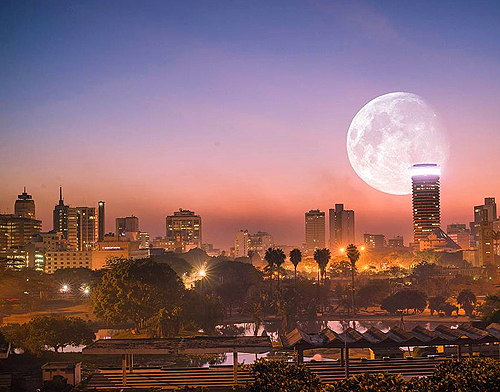 What strikes me about Nairobi – like the slashing ice pellets I just left at home – is that it’s safe here. The bitter reality is that Nairobi is a fortress.
What strikes me about Nairobi – like the slashing ice pellets I just left at home – is that it’s safe here. The bitter reality is that Nairobi is a fortress.
Every shop of any size, every office building, even some petrol stations, are iron or steel fenced boxes. Guards with rather large weapons stand in control of massive gates. As for the hotels, there’s not a diplomat alive who could sneak his wallet or phone in without it being scanned.
Tourists are coming back to Kenya. New hotels planned for Nairobi include a Hilton Garden Inn, Four Points by Sheraton, Radisson Blu and several Best Westerns. These are all designed for the modest businessman or more importantly, the transiting tourist.
Nairobi’s problem is now not so much its security, as its new image.
Talking yesterday with several old friends who reside here I can’t help but share their optimism and excitement. High tech especially, but even a number of global service industry providers are swarming over themselves searching for the best talent to develop business in Nairobi.
The main obstacle? Believe it or not, traffic. Yes, there’s still a rare power outage, digital services are impeded by overuse (an opportunity of its own) and corruption remains serious. Yet as Lagos dwindles with the price of oil, many board rooms are shifting their plans for growth to Nairobi.
Except between 9-11 a.m. or on Sunday, though, it’s … well, hard to move. Yesterday at 7 a.m. it took me two hours to drive the 11½ miles from the airport to the Norfolk Hotel in the city. With a grand chuckle I just referenced Google Maps: the journey is pegged at 24 minutes (“without traffic”) and with traffic? 37, says the very far away Google.
I’m forced to radically rearrange my scheduled guiding of Nairobi attractions. Although the national museum (by Google Maps) is only 1¼ miles by road from The Norfolk, yesterday at 2:15p it took me 40 minutes by cab.
Hardly a decade ago I squeezed in 4 or 5 Nairobi attractions plus a leisurely lunch into a nice day. Now, it’s one attraction …at most.
All the planned new tourist hotels will be near the airport, but even the closest will seem like an arduous journey when there’s nothing else in the area except highways.
This is definitely a problem for tourists. Here are the current workarounds:
1) Arrive Nairobi Saturday night. Suffer a bit of congestion getting into the city or stay out by the airport, and then tour the city on Sunday. Leave your hotel Monday morning by 7:30a for a road journey or transfer to Wilson airport for a local flight somewhere.
2) Arrive any night and go to the suburb of Karen. Decent hotels here are limited and expensive, but you’ll then be able to enjoy a number of famous “Nairobi” attractions in the area virtually on any day of the week. Nairobi city itself would still be restricted to a Sunday schedule.
3) You can still enjoy Kenya’s unique wildlife attractions without starting in Nairobi. You can connect immediately out of Nairobi on one-hour flights to three other cities well positioned for safari travel: Mombasa, Kisumu or Kilimanjaro (in Tanzania).
Mombasa is the most efficient. The city is only 2-3 hours by road south of several excellent wildlife destinations including Tsavo. You can hit the road running after exiting your plane from Nairobi.
Thousands and thousands of mostly European tourists travel to Mombasa for its beaches and never intend to look for wild animals. But unlike my positive feelings about Nairobi’s security, I’d remain cautious about actually staying in Mombasa.
Kisumu might be too novel an idea, yet, because its hotels are just emerging and it’s at least 4 hours by road from the first good wildlife destination. But it has some alluring positives: it’s on Lake Victoria and the hotels are cheap.
Finally, everyone knows about Kilimanjaro, a quick and easy 50-minute flight from Nairobi’s international airport. This is, in fact, the way most East African tourism has run recently so what’s the drawback?
Simple. Once you get to Tanzania, why go to Kenya? There are many good answers to that, but for a first-timer, especially, they’re hard to put forward. Adding a whole new country to your itinerary in Africa, anywhere, is added expense and time, costs and vacation often better used just staying in that one country.
I’d disagree. But then, too, it’s going to be hard for me to realize that my clients won’t enjoy the Norfolk Hotel in downtown Nairobi as much as I do. Nostalgia is a powerful force!
(By the way, the beautiful photo above and below is part of a photo project by Nairobi’s innovative Jambi Forums. Click here to view a stunning range of photos from a great variety of new promising Kenyan artists!)
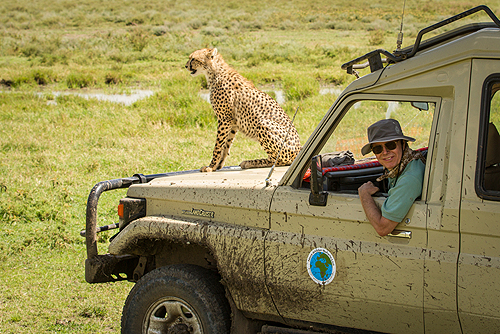 Jim is headed to Africa! For the next two months you can follow his journey here at africaanswerman.com. He’ll be traveling and working in Kenya, Tanzania, South Africa, Botswana and Zambia.
Jim is headed to Africa! For the next two months you can follow his journey here at africaanswerman.com. He’ll be traveling and working in Kenya, Tanzania, South Africa, Botswana and Zambia.
NAIROBI
Feb 10-14
Kenya’s capital has transformed itself in just the last few years. It’s rapidly becoming one of Africa’s most important centers for technology and finance.
SOUTHERN KENYA
Feb 15-20
Kenya’s famous southern bush was the original safari venue for almost everyone! It was where Teddy Roosevelt went hunting, where the greatest population of elephant were first found. Jim will be guiding safaris in Amboseli, Tsavo West and Tsavo East national parks.
NORTHERN KENYA
Feb 21-29
Kenya’s north is completely unlike its south. Highland jungles, deserts with rivers and Kenya’s finest game reserve, the Mara. Jim will be guiding in the Aberdare Mountains, Samburu and the Mara.
NORTHERN TANZANIA
Mar 1-11
At this time of the year this is the place for the greatest wildlife spectacle on earth, the Great Migration! Jim will be guiding in Tarangire, Manyara, Ngorongoro and the Serengeti, his favorite wilderness on earth.
JOHANNESBURG
Mar 12-14
South Africa’s grand megalopolis has clawed itself out of the mess that the end of apartheid left it in. Vibrant, modern and exciting. Jim will be visiting its main sites before boarding one of the world’s finest trains, the Blue Train, for Cape Town.
CAPE TOWN
Mar 14-21
Jim’s second favorite city in the world (after Paris). Cape Town is beautiful, comfortable, welcoming and filled with attractions and deep history. Jim will be guiding people to its important museums, gardens and of course into Cape Point and including the nearby wine country.
BOTSWANA
Mar 22-29
Jim considers Botswana the best game viewing in southern Africa, and he’ll be taking people into the Makgadikgadi Pans, Okavango Delta, Moremi and Chobe national parks.
VICTORIA FALLS
Mar 30-31
Always an outstanding way to end an African safari, Jim will be here with his last safari before returning home.
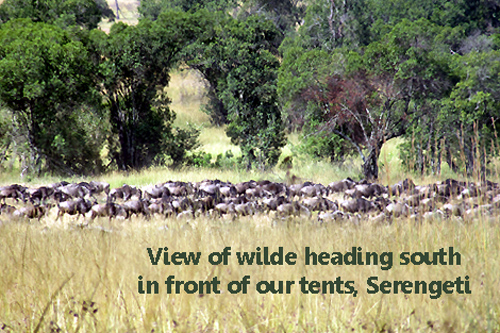 The border between Kenya and Tanzania has been closed in the Mara since 1979, but that didn’t stop us!
The border between Kenya and Tanzania has been closed in the Mara since 1979, but that didn’t stop us!
Historically, the great wildebeest migration has been in the Mara regions of the Ngorongoro/Serengeti/Mara ecosystem from July – September. This is when – historically – the rains have ended in the south while continuing here in the north.
The Mara is Kenya’s best wilderness year-round. After a complex dispute between the two countries in 1979, the all important Mara/Serengeti road and border posts were shut down, and they’ve never been opened since.
This was our final day in the Mara region of the northern Serengeti, still Tanzania but the Serengeti right to the Kenyan border.
We saw lots of wildebeest, not a lot of zebra, a dramatic river crossing and this morning, two male cheetah just waking up to hunt.
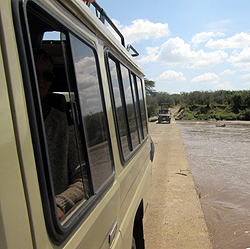
Historically we’d be lucky to see as much as we did these last three days. But the weather’s changing and more of the entire ecosystem is wet for longer than in days past. So I was anxious to know what was happening just across the way in Kenya.
The Mara River is pretty mean, wide and raging where we were staying, and it’s an effective obstacle to going north to Kenya.
There is one cement bridge built years ago when the rivers were all smaller and shallower. It’s usually covered with water, and I expected it would be again today because it rained last night.
Three weeks ago when I was here with another safari there was about three inches of water over the bridge. It’s a false idea that it would be safe for a 1 ton Landcruiser. In fact someone tried (not us). They were fortunate not to be levitated by the water, which is common, but …
… a dead wildebeest was raging down the river, slammed into the vehicle and sent it into the Mara River. The guests were rescued but the vehicle and their belongings were lost.
Today there were about 4 inches above the water, and I was surprised, so immediately off we went towards Kenya!
As soon as we crossed that little bit north the terrain changed considerably and looked exactly like the Maasai Mara I know so well.
There were far fewer trees and bushes, the grass was shorter, and so the vistas were grander. There were lots more visible animals: gazelle, topi, warthog, giraffe – even impala, and of course wildebeest.
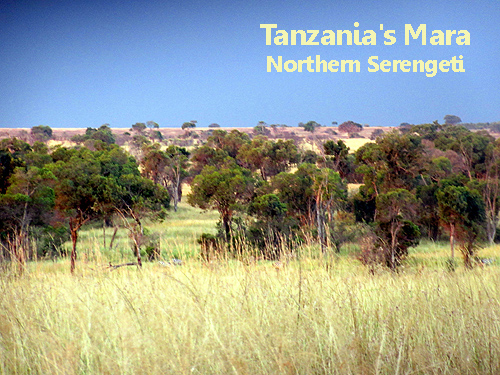
Not a lot. Not as many as I expected. But the terrain reminded me that the beautiful savannah before us is a product of elephants felling forests, a primary among several ecological dynamics. The extraordinary corporate poaching of elephant in the Serengeti in the 1970s and 1980s as opposed to the much better patrolled Kenyan Mara had the unexpected effect of prolonging the northern Serengeti forests.
That’s changing, of course. We are seeing more and more elephant in the northern circuit in Tanzania and lots of felled trees!
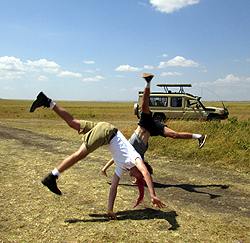
We continued towards Kenya and off to my right I saw a fallen tree in the distance. Underneath resting in its scattered shade were two male cheetah.
Undoubtedly brothers kicked out of their family at the same time, one was clearly agitated, looking all around him and feigning yawns. In the distance was the small group of Thomson’s gazelle that I knew he was contemplating.
His brother was snoozing, but as soon as he stood up, his brother woke up and looked around, amazed to see us.
Nevertheless, cheetah are remarkably docile and friendly animals. They’re no more scared of us than they knew we’re unafraid of them.
We left the brothers to continue to the Kenyan border.
The border is marked by a stone pyramid. Several tracks lead to it from the Tanzanian side, and one from the Kenyan side, down from the Mara Serena hotel.
Anthony and James cartwheeled over the border, in complete defiance of visa regulations! Then, we took a group photo on the Kenyan side of the marker!
Then, fortunately, two Kenyan safari vehicles came up and we chatted with the drivers for some time. Such scant information hardly a good report makes, but they claimed there weren’t any large numbers of wildebeest in the Mara … “yet,” they said.
But we’ve been seeing them come across the Mara to the Tanzanian side for several days, now. Still, the amount of wilde we’ve seen – while impressive and much greater than historically would be the case – it was still hardly a big fraction of the two million animals that make up the great migration.
The lack of the Serengeti herds into the Mara was confirmed today by an email sent around by one of the most respectable properties in the Mara, Governor’s Camp. The email said they were “still awaiting” the Serengeti herds.
(Unfortunately, I don’t think waiting will help. The rains are returning early, and those wildebeest on the Tanzanian side are beginning to move south already.
As I sit writing this back in our Lemala Camp, the blarting of thousands of wildebeest which have just crossed south over the Mara River prompted me to take the title picture above. It seems like all wilde are now moving south, away from Kenya.)
So taking our pack lunch we returned over the cement bridge and traveled along the southern and eastern banks of the Mara seeing once again the great carnage of multiple crossings.
We also saw hippo and giraffe, and a cute scene where a just young adult male elephant charged a line of wildebeest.
He’s just had enough of them, I guess!
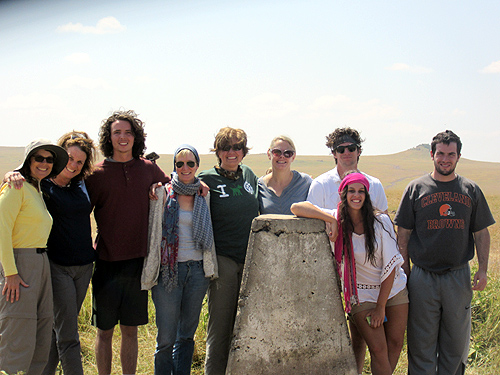
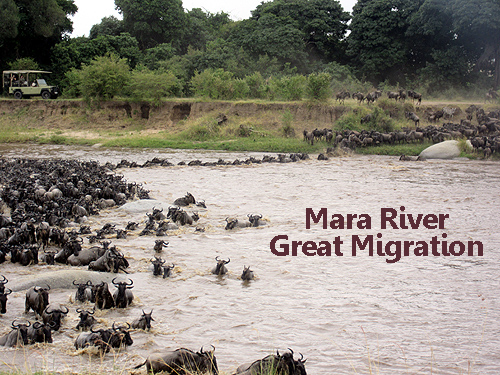 Astoundingly, thousands of wilde were amassed on both sides of the river. Were they going to run into one another, increasing the carnage exponentially?
Astoundingly, thousands of wilde were amassed on both sides of the river. Were they going to run into one another, increasing the carnage exponentially?
Every day I see new confusions in the wild as climate change accelerates. My safari headed out this morning specifically to try to see a great wildebeest migration river crossing, presuming by the calendar it would be from Tanzania into Kenya.
We were lodging on the Tanzanian side of the Mara River.
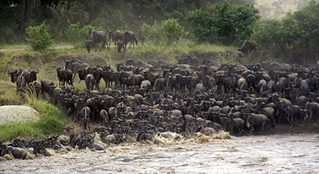 Historically, the 2 million animals involved in the Great Migration will be found almost exclusively in Kenya at this time of the year.
Historically, the 2 million animals involved in the Great Migration will be found almost exclusively in Kenya at this time of the year.
That’s because, historically, the rains south of Kenya have ended. Only in Kenya’s beautifully spectacular Maasai Mara does rain almost every day of the year except in October and November.
Wilde don’t need rain when there are such wonderful rivers as the Mara, Sand and Balagonjwe around. They need grass. Lots of grass. So they travel with the rains, because the rains grow the grasses they have to have.
But in the last decade the rains have gone bonkers. See many of my previous OnSafari blogs throughout the year to see how strange the rains have been and subsequently, have fractured and unpredictable the migration is.
Nevertheless, we had just come all the way through the Serengeti, from the very south. We knew first had that the south was desiccated, just massive swirls of dust over the veld. (And, by the way, hundreds of thousands of nonmigrating Thomson’s Gazelle which need no water in the dry season.)
So until we reached the Mara section of the northern Serengeti, I was pretty sure that conditions were more or less normal, and that it would be great luck for us to see many wilde at all, much less a river crossing.

But as we left the western corridor at Ikoma we began to see clusters of wilde, several hundred strong, here and there as we drove quickly north.
More importantly, I saw green in the veld, and even more importantly than that, massive storms forming all around us.
We reentered the Serengeti at Mugumo and even though the grass was shoulder high there were more and more wilde and even greater numbers of zebra.
My hopes improved! We got into camp late, a beautiful property right on the Tanzanian side of the Mara River. We went to sleep with sounds of elephant trumpeting, hyaena howling and one persistent leopard grunting.
Michael Ertle said he slept only about an hour, because of the persistent gnawing of grass at the edge of his tent. It was zebra. When it rains, the tents direct the water over the eaves where then the most nutrient grasses grow.
So after a quick breakfast we headed out along the river. We made numerous stops for giant crocs, dozens and dozens of them. One I spotted was at least 14 feet long.
But I also noticed lots of dead wilde. That in itself isn’t so unusual, but there seemed to be an unusual number of them and in very radically different states of decay.
And the largest congregation of vultures I’d ever seen. Julie Graham asked if I could estimate how many, and I really couldn’t. I’ve learned to estimate animals on the ground, but the swirls of vultures were daunting.
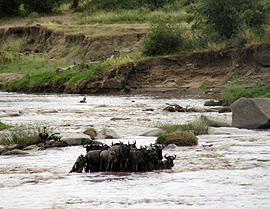
Perhaps thousands? More?
These unusual sites meant something unusual was afoot. The obvious conclusion is that the carnage on the river was greater than normal. Why?
Soon we would learn why. About 15k east of camp we came upon two massive groups of wilde, on opposite shores! Each side looked like it was about to plunge across.
Given the large number of wilde still grazing on the Tanzanian side, clearly the unusual rains had disturbed the predictable course of the migration. Obviously, from our very immediate experience, wilde were crossing both ways, and often.
We parked ourselves about 200m up from the river so as not to disturb the movements. It was around 11 a.m.
Numerous times each side seemed to make a move. There would be agitation and some prancing, wilde moving onto the sand bank but then darting back and drawing dozens back with them.
From the horizon both sides were being pressed by more incoming lines of wilde, migratory files moving in exactly the opposite directions of one another.
It was nearly 12:30p and the standoff continued. Part of group returned for lunch and the lucky die-hards stayed with me.
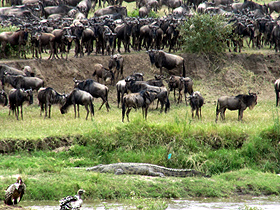
About a half hour later I saw one wilde put his left hoof into the river and I swear it was less than 5 seconds and dozens of wilde started the plunge.
Soon it was a thick of mass wild, loud blarting, splashing and difficult swimming against the strong Mara current, each pushing one in front of them further into the river towards the other side.
The first made it about 7 minutes after the initial plunge. Mothers would stop and turn back, having lost their young. Some, caught by the strong current, were swept onto rocks unable to dive back into the water without drowning.
But most remarkable of all, no crocodile take-downs. When I’ve seen this before, there are dozens of crocs. This time, we saw crocs resting among the running herds and not moving!
The wild are hard-wired to move aggressively and rivers beckon them as their greatest challenge. If there is good grass on both sides of the river, they’ll cross back and forth without other purpose.
That has led to one of the greatest carnages I can remember on the river. And that’s the reason there were no croc take-downs, today.
They’re all full.
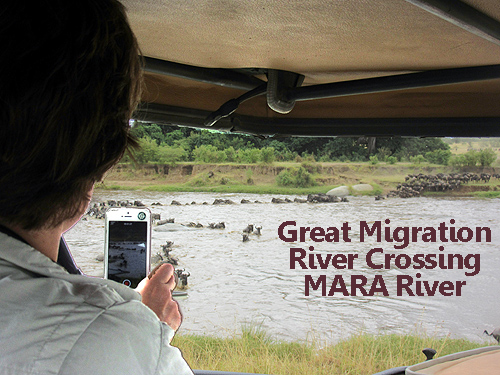
Above Rosalini Fini takes a video of the wildebeest crossing Jim’s safari in northern Tanzania witnessed today.
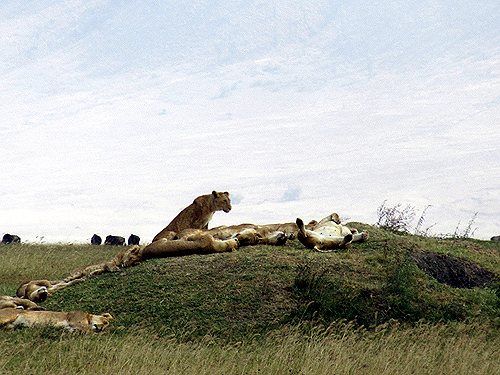 It was just after 7 a.m. and I spotted four lions devouring a wildebeest.
It was just after 7 a.m. and I spotted four lions devouring a wildebeest.
They had obviously just killed it and their faces, necks and front paws and legs were covered with blood and they were eating madly, eating like a cheetah in fact.
Lions don’t go to finishing school, and despite Mary Disse’s wonder if they ever share, they are pretty much gluttons with poor manners. But it’s really only the cheetah that eats as if the world is going to end, because it has such trouble keeping its kill.
Lions are the king of beasts, right?
There were two adult females and two 6-month old juveniles on the kill and they were absolutely frantic, and soon we learned why.
The hyaena were coming in droves.
Whether they anticipated this, or whether the new crater ecology caused by global warming has turned the tables on the king of the beasts, it was now clear why they were eating “like cheetahs.”
The first group of around a dozen cheetah arrived with the tails up, hooting and prancing around in obvious challenge to the small pride on the wildebeest kill. At first the pride took no notice.
When there were 15 hyaena the lions started to get visibly nervous, interrupting their chow-down with raised heads and barred teeth trying to dissuade the hyaena that were coming closer and closer.
At one point everyone was confused as most of the pack of hyaena turned around and chased three new hyaena that were coming towards the kill. That didn’t last long, though, and soon the three that were challenged had joined “the pack.”
There were now more than 20 hyaena and plenty for the attack.
They moved like in thrusts together, all towards the kill. Finally one of the females was bitten on her left hind leg and yelped, and at that point I expected the hyaena to tear apart the lions.
I’d seen it before.
But this time the hyaenas were more hungry than vicious. The lion stood up as if unmolested and walked away from their only partially eaten kill..
The now 25 hyaena pounced on the kill and probably one another, tearing apart every morsel that was left. By the time the lion had walked within 50m of us, found a small rise in the ground and flopped down to lick one another, the kill was practically gone.
I figured the lion had killed the wilde about 20 minutes before we arrived. We were there about an hour, and so in less than 90 minutes a wilde had been killed, eaten and totally consumed.
This is the dry season … I guess. As I’m writing this now, about 5 hours after the event, it’s raining! Reports are that the great wildebeest migration which follows the rains and should be far distant in the Mara in Kenya is fractured and partially still in the Serengeti.
This is climate change. We saw far more wildebeest and zebra in the crater than should be at this time of the year, and they must have grass. Grass only grows when it rains. It’s probably raining in Kenya’s Mara as natural, but it’s also raining here.
Yesterday in the crater we saw a pride of 23 lion near one of the hippo pools. This isn’t normal, either. Certainly there are cases I remember of large prides, but never 23. This absolutely represents a coalition of prides.
I can’t explain it other than to defer to the obvious that things are changing on the veld, and they are changing because the weather is changing. Global warming means more rain for the equatorial regions of the world (and also shorter but deeper droughts in between the heavy rains).
For my clients it was an exceptional morning. After we watched the first kill, we happened upon some juvenile males waiting in ambush for an arriving group of grazing wilde.
As usual, the juvenile males botched the attempt, although it wasn’t completely their fault. By the time the wilde had wandered anywhere near close enough to their ambush spot, there were nearly 20 cars with excited people talking far too loudly.
This is the high season. It’s when there are the most cars in the crater. But because we planned well, and got down onto the floor just after dawn long before most of the cars did, we had a dramatic and splendid morning.
Stay tuned. We’re headed into the far north Serengeti!
 It’s been some years since the circuit has been so busy. Today my group is in the crater, but I won’t be able to write to you about it because the internet is jammed.
It’s been some years since the circuit has been so busy. Today my group is in the crater, but I won’t be able to write to you about it because the internet is jammed.
Bandwidth in Africa is fractional compared to the U.S. and hasn’t seemed to be a problem on the tourist circuit until this season. I’ve always been able to post at least every other day.
Cell towers are everywhere and virtually every property, even a tented camp, has satellite wifi. But now according to my manager friends, use especially by Americans and Europeans is so demanding that basic business conducted by the properties on the internet has been jeopardized.
You can hardly fault visitors: they’re doing nothing abnormal. It’s just that there are a dozen more satellites over America than over the entire continent of Africa.
So properties are taking steps to limit high usage. Several new IT companies in major African towns have developed at remarkable speed bandwidth filters that block use for a variety of possibilities.
Most, for example, now block Facebook, Twitter and Instagram. But the more sophisticated filters block usage by usage. In other words, if you’re trying to stream a video or upload a .raw image, you won’t be able to.
iCloud apps and access are blocked.
And so … am I. As soon as a tear opens in the cloud, you’ll hear from me! Stay tuned!
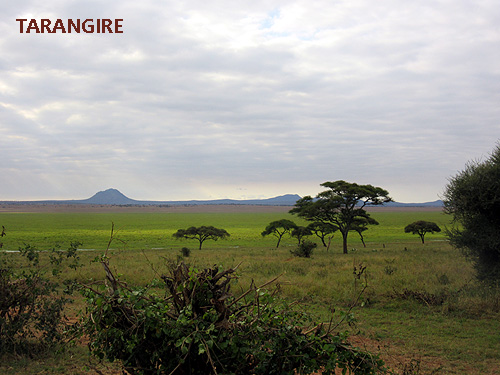 We had finished a fabulous afternoon game drive heading back to camp when an incredibly wild family of elephant intersected the road. I hesitated not knowing if we should proceed.
We had finished a fabulous afternoon game drive heading back to camp when an incredibly wild family of elephant intersected the road. I hesitated not knowing if we should proceed.
Most of the elephant found in Africa, today, are relatively docile: they’ve been habituated to tourists for generations.
This is not true, though, in the more remote parts of Africa or even in the remote parts of its protected areas. That’s where we were: the southern half of Tarangire National Park.

According to the great elephant researcher, Charles Foley, about 2800 elephant live in the northern part of the park, and he calls them “sedentary.” An uncountable number – because they change so often – live in the southern part where we were staying and are “transitory.”
The transitory elephant are much wilder, and I think, healthier. They come through the southern half of Tarangire not to start a home, but to get somewhere else: like the eastern savannah which is equally remote.
I can usually tell the difference after just a few minutes of looking at a family. The sedentary elephant have lost many traditional behaviors, such as keeping their distance from other families and flapping their ears by rocking back and forth their head in warning.
This is because, in my opinion, there are too many elephant in this area. They’ve adapted “socially” by changing their customs. So today in the northern part of Tarangire and many other very insular protected national parks in Africa you can easily see 200 or more elephant together, males, young and mixed families.
They no longer shun other families, because — well, there just isn’t enough space to do so.
Not with the transitory elephant of Tarangire! So just as we had finished the afternoon game drive and were trying to get back to camp before dark, this one large, healthy family of 15 blocked us on the road only 40 meters in front of us. We’d watched them come down, heading for the swamp to water, and taking angry note of two other smaller elephant families in the vicinity.
The grand matriarch started some serious vocalization. This doesn’t mean just trumpeting, but deep rumbles of which we can hear only 10%. The remaining 90% are below our decibel level, so if we can hear rumblings, we know a lot more is being said!
We stopped in the road as she pulled her ears out and moved her head back, a precharge signal. So – but for only a moment – did the other two elephant families stop and take note of this swaggering grandma, but then the matriarch of the nearest one seemed to dismiss the challenge, turned her head to go and continued to saunter away.
The grand matriarch of the wild family lowered her head, trumpeted and charged the insubordinate matriarch of the family walking away.

The matriarch of the retreating family turned and faced her challenger for all of a second. By then the massive likely near 4-ton wild matriarch was practically upon the sedentary matriarch, who then began to run away from here.
But it was too late. She poked the retreating matriarch with her tusks eliciting a trumpet of pain as that smaller family fled faster and faster away. The grand matriarch then huffed and puffed a couple times before slowly walking back to her family, which had gone dead still.
I had decided we couldn’t move while she was running, because her stride together with her speed produces a 4½ ton projectile we couldn’t possibly outrun.
So began the standoff with us. The rest of her family were as still as possums as she jogged back to their front and faced us square on. The rest of the family as if on queue began moving again, seemingly in no discernible direction, just sort of milling about but suddenly we were surrounded.
Any one of the larger adults could have flipped us over. I have a front roof latch above the driver’s seat in the Landcruiser. It was open and I was standing straight through it, the first human she could sense. My clients were all standing up from the back seats.
My group was amazing. I know everyone’s hearts were beating frantically, including my own, but everyone was dead silent and unmoving.
The matriarch waved back and forth in front of us, her giant ears flopping in rhythm, but the good sign was that there was no vocalization.
Most elephant lose much of their sight after about ten years, but they continue to develop an acute hearing and smell. A brush of my bird book against the open roof, someone who is chewing gum and opens their mouth – these are the kinds of things that a grand matriarch standing only 20 meters away might take offense at.
So we just waited. Finally, she settled down and led her family down to the water away from us.
Mary Disse, who is usually not, was speechless! Everyone got extraordinary pictures, but more importantly, experienced viscerally the excitement of truly wild Africa.
We had a grand two days in Tarangire, Africa’s best elephant park. In addition to the tembos, we saw leopard, cheetah, lion, hundreds of impala, buffalo and wildebeest; thousands of zebra, dozens of bird species, and were incredibly lucky to have also encountered oryx and kudu. It was an extraordinary success.
Now we’re relaxing at another of my favorite places, Gibb’s Farm, before heading to the crater. Stay tuned!
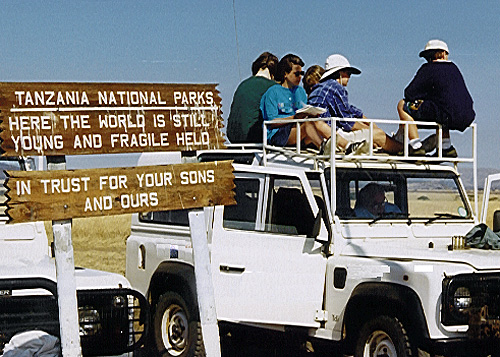 It’s been nearly a decade since I’ve encountered so many families on safari – is the midmarket coming back? Is it time, again, to travel to Africa for a family vacation?
It’s been nearly a decade since I’ve encountered so many families on safari – is the midmarket coming back? Is it time, again, to travel to Africa for a family vacation?
Yes, and yes. For several years, now, I’ve wondered if the midmarket would return. The Great Recession clobbered disposable incomes, especially for families, and it dove-tailed horribly with the election troubles in Kenya then increasing terrorism there after the October, 2011, Somali invasion.
Enough time has passed, now, that our economy is returning to a semblance of normality (even as much of Europe has not) AND terrorism in East Africa is way down.
Family safaris have returned: From Serena to Sopa to lower market family group safaris, the circuit we just completed in Tanzania was jam packed.
I’ll be in Kenya in a few weeks and will be able to assess that as well, especially as the British government has removed its travel warnings on Kenya’s so popular coast.
It’s a definite generalization, but it seems to me that terrorism is moving out of the Third World and back to the western world in some bold attempt by the bad guys to prove they can penetrate western security.
Needless to say, a terrorist incident like occurred on the Tunisian beaches and may have occurred at the Naval Yard yesterday would represent much greater victories for the bad guys than closing a few beach hotels in Kenya.
I think families know this, now, and as their finances stabilize they understand what wonderful memories a family safari creates.
At Rivertrees Country Inn a few weeks ago in Arusha I was talking to one family of a very typical composition: grandfather and grandmother, plus two families of their two children with six grandchildren in total, all under 13 years old.
That is the perfect composition for a family safari, and as I was talking with the adults one of the 9-year olds saddled up to Bibi (Grandma) to tell her that this was the best family vacation he had ever had!
It was only their second day but the colobus monkeys were calling from the ground’s high fig trees and mongoose were scampering over the beautifully landscaped gardens.
Kids love a family safari because of the wildness. Imagine being a kid who lives his day with one rule on top of another. It must be absolutely liberating to experience a situation where his parents are as restricted as she feels: Nobody, not even adults, can walk out there with the lions!
I think, too, like learning languages at an early age facilitates greater language skills as an adult, immersing yourself in the wilderness at a young age primes the spirit not just to be adventuresome but to refresh the natural link every person has with the organic world.
Saying it more simply, it’s one of the few things for which they lower their phones.
By the way, I did discover an interesting drawback to the summer family safaris now returning to East Africa. Once back in the camp or lodge where civilization returns, the enormous drain on the internet system from kids’ phones is causing data congestion.
Gerd, the manager at Gibb’s Farm, is so worried about this that he’s researching software that would clamp the data availability per device, ensuring for example that his own office emails would work normally while ending streaming and photo sharing of his clients.
If that bothers you, imagine how it bothers Africans who have a much greater use of cell phones than Americans.
There are 26 satellites carrying cell phone data over North America. There are only 2 over the entire continent of Africa.
That can’t last for too long. There’s a lot more that Africa needs from the global internet network than Facebook.
My McGrath Family Safari ended yesterday. It was near perfect, and I don’t say that lightly, because such things are avoiding car breakdowns or camp booking glitches in the high season is often a matter of luck, not skill.
So Ngei was with us, I guess! As it was with the many other happy families I encountered so far this season!